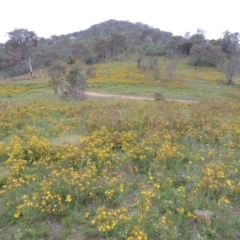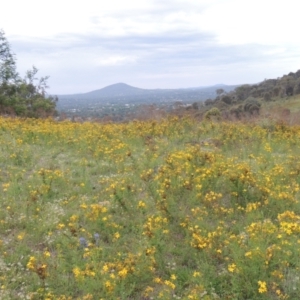St John's Wort at Tuggeranong Hill
Identification history
| Hypericum perforatum | 10 Jan 2024 | michaelb |
Identify this sighting
Please Login or Register to identify this sighting.
Significant sighting
michaelb noted:
10 Jan 2024
On my recent visit to the western slope/ridge of Tuggeranong Hill, the amount of St Johns Wort on the hill was astounding. I've visited there before & I reckon there is a multiple of 100 times the amount of the wort compared to a visit I made in 2015. It is very concerning for the future of the whole of the western side of the hill and the native flora being pushed out.
User's notes
On the western slopes/ridge of Tuggeranong Hill. The photos look to the north, the east & hill top, and south-east toward Rob Roy.
12 comments
michaelb
wrote:
10 Jan 2024
With this sighting I show the expansive spread of St John's Wort that is now covering the slopes and the top of the western ridge of Tuggeranong Hill. 3 other sightings from the nearby slopes are 4543276, 4543272, 4543279 :-
https://canberra.naturemapr.org/sightings/4543276, Hypericum perforatum (St John's Wort)
Hypericum perforatum (St John's Wort)
https://canberra.naturemapr.org/sightings/4543276, Hypericum perforatum (St John's Wort)
Hypericum perforatum (St John's Wort)
michaelb
wrote:
10 Jan 2024
Hi @VeraKurz .. Sorry to be the bearer of bad news. If you have not explored this part of the hill lately, I think you and FOTH should be made aware of this.
Mike
wrote:
10 Jan 2024
Beyond depressing in other nature reserves too. You can't expect volunteers to do anything about it. Rangers have been mapping some but there are few resources to control it.
VeraKurz
wrote:
11 Jan 2024
Hi Michael and all.
Yes, it is certainly rampant, and several wet summers have seen it flourish right across the reserve. To be honest, I'm not really sure how much our group can do to control it. We really just target a few key areas for SJW treatment.
Yes, it is certainly rampant, and several wet summers have seen it flourish right across the reserve. To be honest, I'm not really sure how much our group can do to control it. We really just target a few key areas for SJW treatment.
MichaelMulvaney
wrote:
12 Jan 2024
SJW does flourish in wet years - particularly in those areas where overgrazing by stock, kangaroos and/or rabbits have significantly reduced native grass cover. However it will die back in dry years and spraying, slashing flower heads and grazing management can help control it. It also looks worse than it actually is in that although it looks to be blanketing an area at ground level many native grasses and herbs can still persist. Groups like FOTH and Red Hill Regenerators have to target priority areas and live with the knowledge that dry weather will see a reduction - it can be depressing but it is not a lost cause.
michaelb
wrote:
12 Jan 2024
Hi Vera. I wasn't expecting you and FOTH to deal with the issue, and I'm sure you do your best. I was just expressing my dismay at what is happening to Tugg Hill and what will happen in the future because of its negative effect on the native ground cover flora. I wonder what Tugg Hill will look like in 10 years time if the trend continues.
michaelb
wrote:
12 Jan 2024
Hi Michael M. I have to respectfully disagree with you re the SGW. (1) There is no apparent spraying on the great majority of Tugg Hill, and no slashing or grazing management at all. (2) Initially when the SJW has moved into an area the native grasses and forbs persist for a short while. But over time the SJW becomes more dense in its growth and crowds out the natives. While it may be less visible in dry years the roots persist and then when the rain comes the SJW increases it coverage and hold. (3) SJW also changes the soil structure and composition. Then many of the natives just die out, especially the more sensitive species. I've seen this happen. (4) If you want to see the long term effect of SJW when left unmanaged, as it has been on Tugg Hill, then visit Urambi Hills. Start from the entrance at Meredith Circuit Kambah and walk to the hill top. It is not nice.
Mike
wrote:
12 Jan 2024
Is it out- competing the Patersons Curse? I don't recall any blue fields this seaon. Echium generally flowers earlier than SJW, but might be missing out with all the competition.
MatthewFrawley
wrote:
17 Jan 2024
At least Mount Taylor looks pretty impressive in that first photo. I'm going to focus on that.
Please Login or Register to comment.
Nearby sightings
Location information
- Coordinates 149.100020-35.450572
- Altitude 731.2m
- Maps Tuggeranong Hill
- Places Conder, ACT
Sighting information
- 100000 Abundance
- 7 Jan 2024 05:58 PM Recorded on
- michaelb Recorded by
-
Collections
michaelb's Flagged sightings Discussions.
Additional information
- 30cm to 1 metre Plant height
- True In flower
Species information
- Hypericum perforatum Scientific name
- St John's Wort Common name
- Not Sensitive
- Exotic
- Noxious or High Risk Weed or Pest
- Up to 1671.7m Recorded at altitude
- Machine learning
-
In flower
- External link More information
Record quality
- Images or audio
- More than one media file
- Confirmed by an expert moderator
- Nearby sighting(s) of same species
- GPS evidence of location
- Description
- Additional attributes















